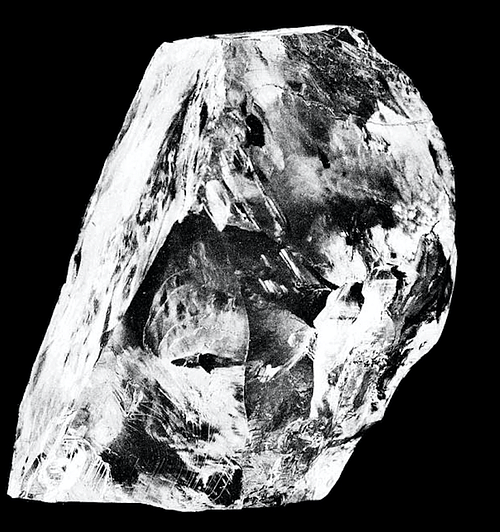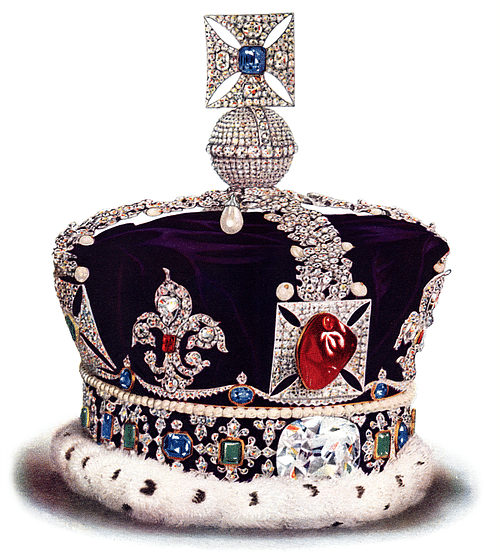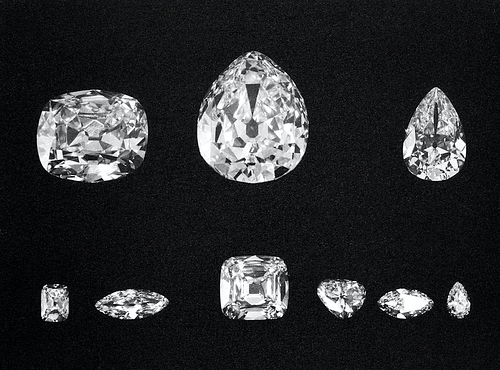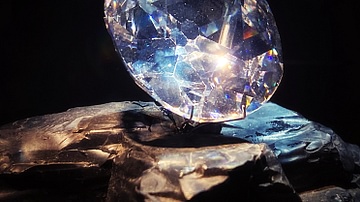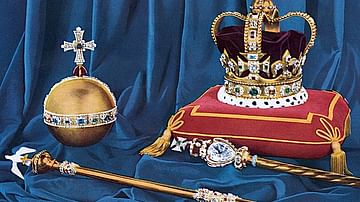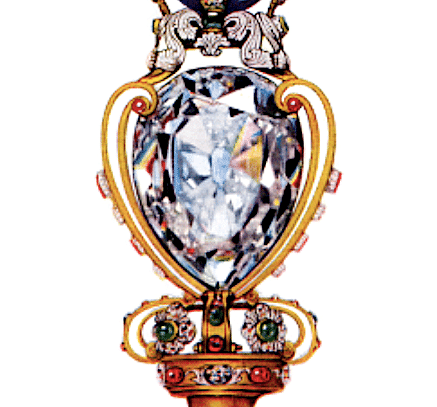
The Cullinan Diamond was discovered in Transvaal, South Africa in 1905 and presented as a birthday gift to Edward VII of England (r. 1901-1910) by the Transvaal Government. It weighed well over 3,000 carats, making it the largest gem-quality rough diamond ever found. When discovered, it was valued at over $21 million dollars in today's money.
Despite its tremendous value, the diamond was famously sent by registered post from South Africa to England. The rough stone was then cut into nine large gemstones, each given a name Cullinan I to IX, and 96 smaller diamonds. The largest diamond is the 530-carat Cullinan I, also known as the Star of Africa, which now sparkles in the royal sceptre of the British Crown Jewels. It is the largest colourless cut diamond in the world. The second largest stone, Cullinan II, the 317-carat Second Star of Africa, was set into the Imperial State Crown, which is used at coronations of British monarchs. The other larger diamonds are variously worn as pendants and brooches and remain a part of the private jewellery collection of the royal family.
Discovery & Gift to Edward VII
The Cullinan diamond was discovered on 26 January 1905 and is named after Thomas Cullinan, the chairman of the Premier Mine where it was found near Pretoria in the Transvaal, then a British colony (now a province of South Africa). The stone was discovered by Frederick G. S. Wells, Surface Manager at the mine who received a $10,000 bonus for his discovery. The massive uncut diamond weighed 3,106 carats and measured almost 10.1 centimetres (3.9 in) in length and 6.35 cm (2.5 in) in width, making it the largest uncut diamond ever found. It was an extraordinary example of a rough diamond for its sheer size but also for the excellent purity and its unique blue-white colour. The stone was first put on public display in the Standard Bank of Johannesburg.
In 1907 the Cullinan stone, still in its rough state, was sent to London by the Premier Mine Company owners to try and find a suitable buyer. Curiously, it was simply posted by registered mail while a decoy was used in an armoured ship everyone thought contained the real stone. Arriving safely enough, no private buyer showed any interest and so, pushed by the Prime Minister of Transvaal, General Louis Botha (l. 1862-1919), the Transvaal Government bought the stone from the Premier Mine Company. The price paid was £150,000 (over £18 million or $21 million today).
In 1907 it was decided by the Transvaal Government to present the diamond to King Edward VII of England as a present for his 66th birthday. The glamorous gift was meant to help restore relations between Britain and South Africa following the Second Boer War (1899-1902) between the two countries. The stone was taken by police escort to Sandringham House in Norfolk for presentation to the king on his birthday, 9 November 1907. The king then gave it to the care of Scotland Yard, the famed headquarters of the Metropolitan Police, until it had been decided what exactly to do with it.
Cullinan I: the Sovereign Sceptre
In early 1908 it was decided to cut the rough and opaque diamond into brilliant gemstones. In order to get ideas on what exactly to do with the hoped-for gems, a team of experts visited the British Crown Jewels in the Tower of London to see where they might be installed. The precious stone was then sent to the diamond experts Joseph Asscher and Company of Amsterdam for cutting. The process to cut out and polish sparkling gems from the huge mass of rough stone began in February 1908 and took the team of three specialists eight months to complete. The original piece was first cut into two pieces weighing 516.5 and 309 carats. The groove for the first cut alone took four days to prepare and when Joseph Asscher himself attempted to make it, the steel knife snapped. A second attempt was successful, and the original stone was eventually cut into seven large pieces. These were then cut and polished to produce nine large stones, each being given the rather unimaginative name of Cullinan plus a Roman numeral from I to IX. Cullinan I and II were formally presented to Edward VII on 21 November 1908, almost exactly one year after he had first set eyes on the uncut stone. This pair of gems, then the largest cut diamonds in the world, were immediately put on public (and very safe) display in the Tower of London.
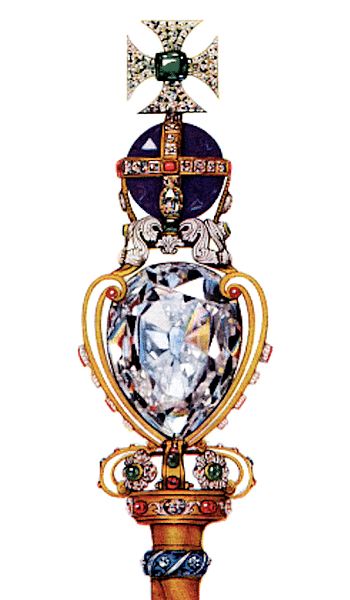
The pear-shaped Cullinan I was the largest stone of the group, weighing a massive 530.2 carats - the famous Koh-i-Noor diamond from India, also part of the British Crown Jewels, weighs a mere 105.6 carats. Cullinan I is the largest colourless top-quality cut white diamond in the world and the magnificent gem did at least benefit from a new and more romantic name: the Star of Africa. Initially, Cullinan I and Cullinan II (see below) were paired together in what must have been a dazzling but rather impractical pendant brooch. Following Edward VII’s death in 1910 there was a rethink of just what to do with these magnificent jewels.
The Cullinan I was added to the Sovereign's Sceptre, ready for the coronation of George V (r. 1910-1936) in 1911 CE. This is, in fact, what the original design team had decided the largest stone should be used for back in 1908. The sceptre, which is also known as the King’s Sceptre, was made in 1661 for the coronation of Charles II of England (r. 1660-1685), and it symbolises worldly regal power and good governance. The stone is cradled upright between a two-armed gold mounting at the top of the sceptre which allows it to be seen from all angles. This mounting is hinged to easily allow the stone to be removed. Due to the extra weight of the diamond, it was necessary to reinforce the length of the sceptre. Above the diamond is an amethyst monde, itself set with diamonds and one large emerald. The sceptre, which measures 92.2 cm in length, was part of the regalia used by Queen Elizabeth II at her coronation in 1953.
Cullinan II: the Imperial State Crown
The second largest stone cut from the original diamond was the oval-shaped Cullinan II. It weighs 317 carats and has acquired the name the Second Star of Africa. In 1910, Cullinan II was set into the gold Imperial State Crown, also known as the Crown of State. This crown was originally created for the coronation of Queen Victoria (r. 1837-1901) in 1838 as a lighter alternative to the traditional St. Edward's Crown. It was also used by Edward VII at his coronation. The crown was remodelled, still with the Cullinan II in prime position, and used by George VI (r. 1936-1952) in his coronation in 1937 and by his daughter and successor Elizabeth II at her coronation.
The Cullinan II is set at the front of the crown’s band directly below another famous gemstone, the Black Prince's Ruby (actually a balas or spinel). The famous Stewart Sapphire had been in this position but was moved to the back of the crown to make way for the Cullinan II. Besides coronations, the crown also makes an appearance at various state occasions such as the annual State Opening of Parliament. Both the crown and the sceptre with Cullinan I are on public display in the Jewel House inside the Waterloo Barracks of the Tower of London. As with Cullinan I, the Cullinan II can easily be removed from its crown setting so that it might be worn as a pendant or brooch.
Cullinan III-IX
The other seven large diamonds cut from the original stone, named Cullinan III to IX, are all brilliants and sizeable diamonds in their own right. To make the best use of the material, various shapes were cut: three are pendeloque (pear-shaped), two are marquise cuts (elongated lozenges), one is rectangular and one square. Photographs were taken to document the cutting and polishing process, and many of these are now part of the Royal Collection. In addition to the big nine, another 96 small brilliant-cut diamonds were cut from the original Cullinan piece. There was also a remainder of unpolished fragments together weighing nine carats. Some 65% of the original rough diamond had been lost. The two star pieces of this group are Cullinan III, which is a pear-shaped stone weighing 94.4 carats, and the square-cut Cullinan IV which weighs 63.6 carats.
King Edward VII bought Cullinan VI and VIII from Asscher who kept the other large Cullinan stones. The Dutch diamond merchant also kept the 96 smaller stones and unpolished fragments as his fee for cutting the original rough stone. The South African government subsequently acquired all of these stones and presented them to Queen Mary (l. 1876-1953), the consort of George V in 1910 to commemorate the formation of the Union of South Africa that year. In 1911, both Cullinan III and IV were set into the coronation crown of Queen Mary.
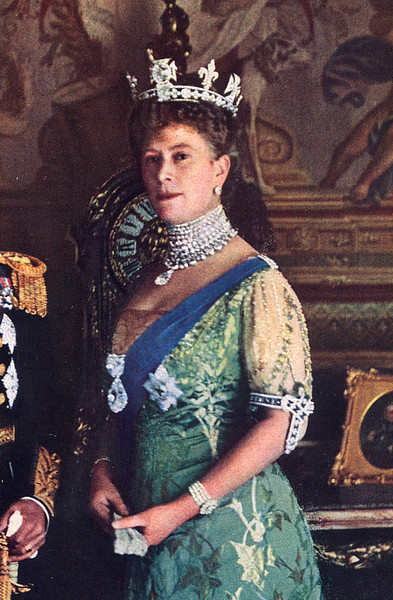
As noted, both Cullinan I and II can be removed from their settings and joined to be worn as a pendant and this was famously done by both Queen Alexandra (consort of Edward VII) and Queen Mary. The latter queen consort even wore a pendant of Cullinan I and II and another pendant of Cullinan III and IV all at once for the State Opening of Parliament on 6 February 1911. The latter two diamonds, known affectionately by the royals as 'the chips', are still sometimes worn as a brooch and pendant with the drop Cullinan IV suspended below the square Cullinan III. Both stones are set in a fine lattice setting made of platinum. This combination has been worn by the Queen and, more recently, by the Duchesses of Cornwall and Cambridge. All seven Cullinan diamonds (III-IX) became part of the personal jewellery collection of Elizabeth II, who was bequeathed them by Queen Mary in 1953.
